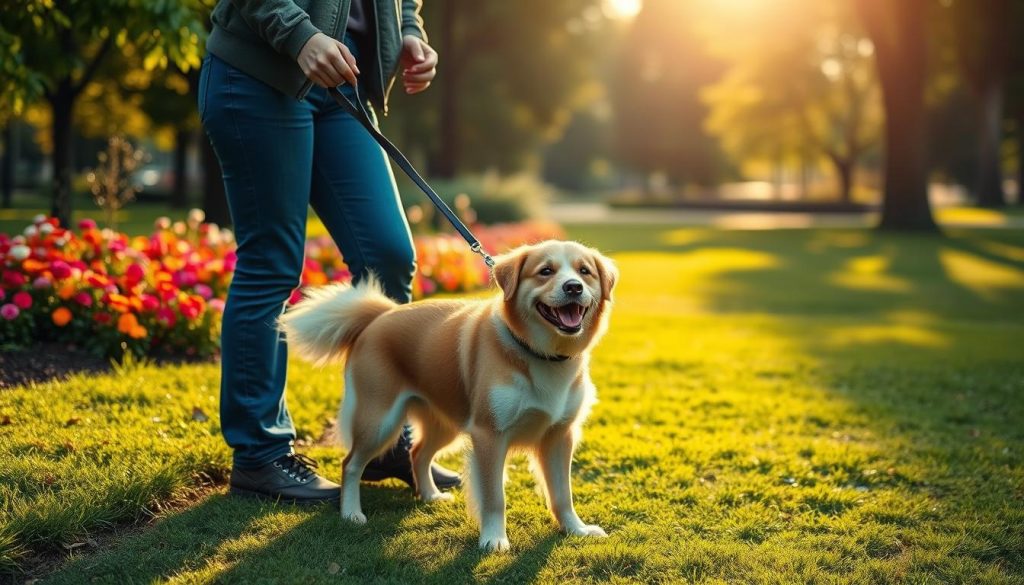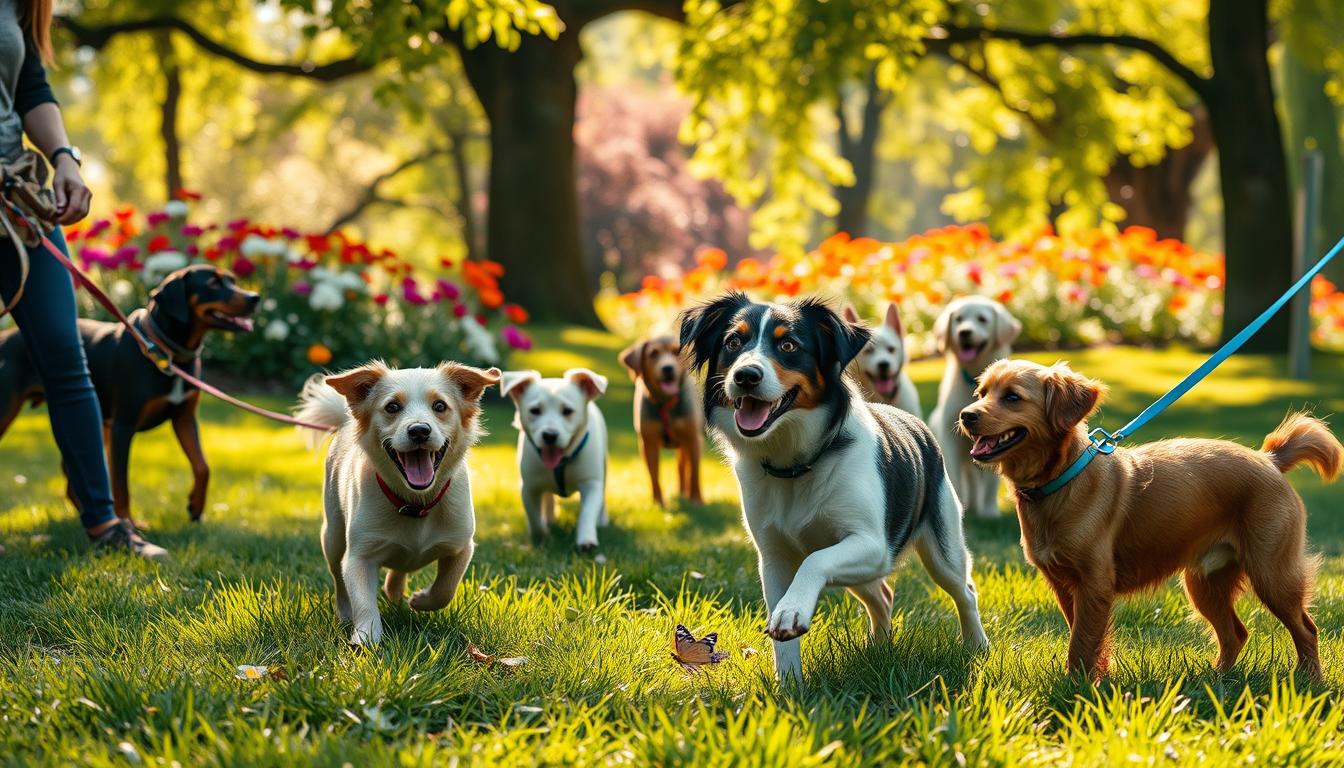As a passionate dog owner, I see our daily walks as a chance to bond and explore together. In this guide, I’ll share my best dog walking tips. They’re for both new and experienced dog parents to keep their dogs safe, happy, and engaged on walks.
Learn how to handle leash etiquette and make walks more fun. These tips will turn your daily walks into exciting adventures for you and your dog. Let’s start and make every dog walk a success!
The Importance of Regular Dog Walks
Regular dog walks are more than just fun; they’re crucial for your dog’s health. They offer physical and mental benefits, and they help you bond with your pet.
Physical and Mental Stimulation
Walking your dog is great exercise for them. It keeps them fit and healthy. It also helps their muscles, joints, and heart stay in good shape.
But it’s not just about the body. Dog walks also keep their minds active. They get to see new things, hear different sounds, and smell new smells. This helps prevent boredom and stops them from getting into trouble.
Bonding with Your Furry Companion
Walking your dog is a great way to spend quality time together. You’ll make memories and grow closer. It builds trust, communication, and understanding between you and your dog.
Walking your dog, whether around the block or in nature, is key to being a good pet owner. It keeps your dog happy and healthy, and it strengthens your relationship with them.
Dog Walking Tips

Walking your dog can be fun and rewarding. It’s important to prepare and know how to make every walk special. As an experienced dog owner, I’m excited to share some practical dog walking tips to make your walks better and strengthen your bond with your dog.
First, pick the right leash for your dog’s size and personality. A good leash lets your dog explore while keeping them safe. Then, learn basic commands like “sit,” “stay,” and “heel.” These commands help you control your dog and keep them safe during walks.
- Invest in a high-quality, adjustable leash that suits your dog’s size and energy level.
- Teach your pup essential commands like “sit,” “stay,” and “heel” to ensure better control during the walk.
- Practice positive reinforcement training to reinforce good behavior and build your dog’s trust.
Another key dog walking tip is to plan your route well. Look for paths with few distractions and lots of space for sniffing. Always watch out for dangers like busy roads or aggressive animals. Be ready to change your dog’s focus if needed.
Lastly, remember to bring important items like water, treats, and cleanup bags. Keeping your dog hydrated and rewarding them for good behavior makes walks more fun for both of you. By following these tips for walking dogs, you’ll learn how to walk a dog properly and enjoy the benefits of effective dog walking techniques.
Preparing for the Walk

As a dog owner, getting ready for a walk is key. Before you go, make sure you have all the dog walking essentials. This will keep your dog safe, comfy, and fun during the walk.
Essential Dog Walking Gear
- A sturdy leash: Pick one that’s easy to hold and lets your dog move freely without tangling.
- Poop bags: Always carry poop bags to clean up after your dog during the dog walk.
- Water and a collapsible bowl: Keep your dog hydrated, especially in warm weather. Bring a portable water bowl and a refillable water bottle.
- Treats: Pack your dog’s favorite healthy snacks to reward good behavior and encourage positive dog walking habits.
- First-aid kit: It’s wise to have a small first-aid kit for any minor injuries or issues that might come up during the walk.
With these dog walking supplies, you’ll be ready to bond with your furry friend and enjoy the outdoors. A bit of preparation makes for a fun adventure for both you and your dog.
Mastering Leash Etiquette

Learning dog leash training and leash manners is key for a great walk with your dog. It makes walks enjoyable for both of you. Knowing how to walk a dog on a leash is very important.
Teaching your dog to walk calmly is a big part of proper leash handling. It makes walks better for you and helps your dog feel safe. Here are some tips to help you and your dog walk well together:
- Start with short, structured walks: Begin with brief, controlled leash walks, gradually increasing the duration as your dog learns to walk politely by your side.
- Use positive reinforcement: Reward your dog with treats and praise when they walk calmly on the leash, reinforcing the desired behavior.
- Manage pulling: If your dog starts to pull, stop walking and wait for them to calm down before continuing. This teaches them that pulling doesn’t get them where they want to go.
- Practice “heel” and “stay”: Teach your dog these basic commands to help them understand when they should be walking close to you and when they should remain stationary.
- Be patient and consistent: Mastering leash manners for dogs takes time and practice, but with persistence and positive reinforcement, your pup will soon be a pro at walking politely on the leash.
By following these tips and making dog leash training a part of your daily routine, you’ll enjoy stress-free walks with your dog.
Keeping Your Dog Safe and Engaged
As a responsible dog parent, your top priorities during our walking adventures should be ensuring your pup’s safety and keeping them mentally engaged. By navigating potential hazards and incorporating enriching activities, we can transform every stroll into a fulfilling experience for both of you.
Safety first! When traversing busy streets or unfamiliar environments, remain vigilant. Keep your dog securely leashed, and be mindful of traffic, uneven terrain, and any potential dangers. Regularly check-in with your canine companion, rewarding them with praise and treats for their attentiveness.
To prevent boredom and maintain your dog’s interest throughout the walk, try incorporating interactive games and activities. Bring along their favorite toys, and encourage them to sniff, explore, and engage with their surroundings. Vary the pace and route to introduce new sights, sounds, and smells, keeping their mind stimulated and their tail wagging.

